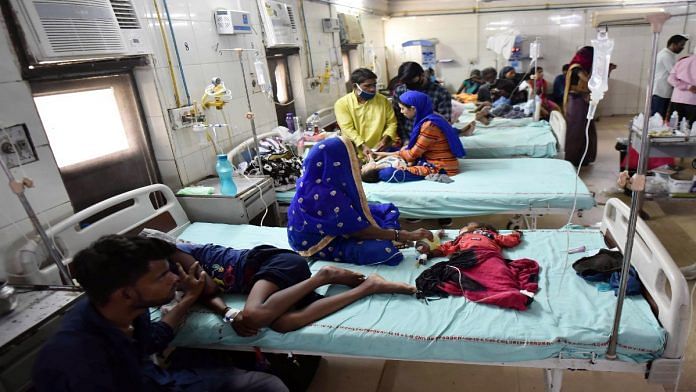New Delhi: Kerala has emerged as the state with the best overall health performance for the fourth consecutive year, while India’s most populous state Uttar Pradesh is at the bottom of the list, according to federal think tank NITI Aayog’s fourth Health Index report released Monday.
However, the report ranks UP at the top in what is called ‘incremental performance’, registering the highest ‘incremental’ change from the base year (2018-19) to reference year (2019-20). The state improved its performance in 33 of 43 indicators/sub-indicators, the report said.
Developed by incorporating 24 indicators in three specific areas — ‘health outcomes’, ‘governance and information’ and ‘key inputs and processes’ — the health index has been calculated as a weighted average of all the indicators in each state and union territory for a base year (2018-19) and a reference year (2019-20).
Among union territories, national capital Delhi and Jammu & Kashmir ranked among the bottom in terms of overall performance, but emerged near the top in terms of ‘incremental performance’.
Mizoram emerged as the best performer, overall as well as incremental, among the smaller states. Nagaland was at the bottom.
Also Read: Lack of senior doctors, only 3-5% hospital beds: NITI Aayog finds big gaps in emergency care
Report doesn’t include Covid impact
The indicators are selected on the basis of their importance and availability of reasonably reliable data at least annually from existing data sources such as the Sample Registration System, Civil Registration System and Health Management Information Systems.
The report, however, does not incorporate the impact of Covid-19 on health outcomes or any of the other indicators as the index performance relates to base year (2018-19) and reference year (2019-20), largely the pre-Covid period.
For the fourth edition of the health index report, all states and UTs participated except West Bengal. Ladakh was not included due to non-availability of data.
Overall vs incremental performance
Among the larger states, Kerala and Tamil Nadu ranked first and second in terms of overall performance with index scores of 82.20 and 72.42 respectively. However, in incremental performance, the two ranked 12th and 8th respectively.
The performance of Kerala worsened or remained stagnant from 2018-19 to 2019-20 on nearly half the indicators/sub-indicators.
A review of the incremental performance across indicators/sub-indicators revealed that a vast majority of the larger states registered improvement in performance across the key health outcome indicators — ‘neonatal mortality rate’, ‘under-five mortality rate, ‘sex ratio at birth’ and ‘maternal mortality rate’.
Among the larger states, only four states improved their base year (2018-19) rank in the reference year (2019-20) — Telangana, Gujarat, Punjab and Assam.
Ten states including Kerala, Tamil Nadu, Maharashtra, Chhattisgarh, Haryana, Jharkhand, Rajasthan, Madhya Pradesh, Bihar and Uttar Pradesh retained their ranks.
Five states saw a decline in their ranking, with Odisha recording the steepest (two spots) and Andhra Pradesh, Himachal Pradesh, Karnataka and Uttarakhand slipping one each.
Performance in 4 key health outcome indicators
According to the health index report, there is large inter-state variation in neonatal mortality rate (NMR), under-five mortality rate (U5MR), maternal mortality ratio (MMR) and sex ratio at birth (SRB), the four key health outcome indicators.
Among the larger states, Kerala has the lowest NMR, U5MR and MMR, while Madhya Pradesh had the highest NMR and U5MR and Assam had the highest MMR.
Based on the reference year values for NMR, U5MR and MMR, the states were classified in three categories, i.e., aspirants, achievers and frontrunners.
In case of NMR and U5MR, five states qualified for the ‘frontrunner’ category — Himachal Pradesh, Kerala, Maharashtra, Punjab and Tamil Nadu — and the NMR in these states ranges between 5 and 13 neonatal deaths per 1,000 live births.
Kerala and Tamil Nadu have already reached the Sustainable Development Goals (SDG) NMR target, recording 12 neonatal deaths per 1,000 live births, while Himachal Pradesh, Maharashtra and Punjab, with 13 neonatal deaths per 1,000 live births, are likely to hit the target soon.
UP has poorest institutional delivery
Among the larger states, the highest percentage of institutional deliveries was recorded by Kerala in 2014-15 (96 per cent) and Telangana in 2019-20 (96.3 per cent).
In an institutional delivery, life-saving equipment and hygienic conditions reduce the risk of death and complications among mothers and infants.
The lowest percentage of institutional deliveries was registered in Uttar Pradesh, both in 2014-15 (43.6 per cent), and in 2019-20 (60.8 per cent).
From 2014-15 to 2019-20, 15 of the 19 larger states registered an increase in institutional deliveries, while it declined in the remaining four states. Telangana registered the highest increase (62.8 per cent) while Gujarat (-5.2 per cent) registered the steepest decline.
Shortage of specialists
All the larger states had a shortage of required specialists in district hospitals, according to the report. This varied from 2 per cent in Rajasthan to 58 per cent in Madhya Pradesh.
From base year (2018-19) to reference year (2019-20), the number of specialists in Bihar increased by 23 per cent, the highest, while Uttarakhand registered the biggest drop (-19 per cent).
According to the data, half the states registered a decline in the state government health expenditure component in total state expenditure from 2015-16 to 2016-17. In 2015-16, the highest percentage of state government health expenditure was observed in Assam (7.5 per cent) and the lowest in Bihar and Odisha (4.4 per cent). In 2016-17, the highest percentage was observed in Kerala (7.4 per cent) and lowest in Madhya Pradesh (4.3 per cent).
(Edited by Gitanjali Das)
Also Read: Bengaluru best city for jobs & economic growth, Kolkata worst — Niti Aayog’s SDG Urban index



